Our sun may have a companion that disturbs comets from the edge of
the solar system - a giant planet with up to four times the mass of
Jupiter, researchers suggest.
A NASA space telescope launched last year may soon detect such a stealth companion to our sun,
if it actually exists, in the distant icy realm of the comet-birthing
Oort cloud, which surrounds our solar system with billions of icy
objects.
The potential jumbo Jupiter would likely be a world so frigid it is
difficult to spot, researchers said. It could be found up to 30,000
astronomical units from the sun. One AU is the distance between the
Earth and the sun, about 93 million miles (150 million km).
Most systems with stars like our sun - so-called class G
stars - possess companions. Only one-third are single-star systems
like our solar system.
Not a nemesis
Scientists have already proposed that a hidden star, which they call "Nemesis,"
might lurk a light-year or so away from our sun. They suggest that
during its orbit, this red dwarf or brown dwarf star would regularly
enter the Oort cloud, jostling the orbits of many comets there and
causing some to fall toward Earth. That would provide an explanation for
what seems to be a cycle of mass extinctions here.
Still, other astronomers recently found that if Nemesis did exist, its orbit could not be nearly as stable as claimed.
Now researchers point to evidence that our sun might have a different sort of companion.
To avoid confusion with the Nemesis model, astrophysicists John Matese
and Daniel Whitmire at the University of Louisiana at Lafayette dub
their conjectured object "Tyche" - the good sister of the goddess
Nemesis in Greek mythology, and a name proposed by scientists working on
NASA's Wide-Field Infrared Survey Explorer (WISE) space telescope.
It is the WISE observatory that, using its all-seeing infrared eye,
stands the best chance of having spotted Tyche, if this companion to the
sun exists at all, the researchers said. [WISE telescope's amazing images
Comet-flinging sun companion
The researchers noted that most comets that fly into the inner solar
system seem to come from the outer region of the Oort cloud. Their
calculations suggest the gravitational influence of a planet one to four
times the mass of Jupiter in this area might be responsible.
Two centuries of observations have indicated an anomaly that suggests
the existence of Tyche, Matese said. "The probability that it could be
caused by a statistical fluke has remained very small," he added.
The pull of Tyche might also explain why the dwarf planet Sedna has such an unusually elongated orbit, the researchers added.
If Tyche existed, it would probably be very cold, roughly minus 100
degrees F (-73 degrees C), they said, which could explain why it has
escaped detection for so long - its coldness means that it would not
radiate any heat scientists could easily spot, and its distance from any
star means it would not reflect much light.
"Most planetary scientists would not be surprised if the largest
undiscovered companion was Neptune-sized or smaller, but a Jupiter-mass
object would be a surprise," Matese told Space.com. "If the conjecture
is indeed true, the important implications would relate to how it got
there - touching on the early solar environment - and how it might
have affected the subsequent distributions of comets and, to a lesser
extent, the known planets."
Is Tyche really out there?
The fact of Tyche's existence is questionable, since the pattern seen in the outer Oort cloud is not seen in the inner Oort.
"Conventional wisdom says that the patterns should tend to correlate, and they don't," Matese said.
If the WISE team was lucky, it caught evidence for the Tyche solar
companion twice before the space observatory's original mission ended in
October. That could be enough to corroborate the object's existence
within a few months as researchers analyze WISE's data.
But if WISE detected signs of Tyche only once (or not at all),
researchers would have to wait years for other telescopes to confirm or
deny the potential solar companion's existence, Matese said.
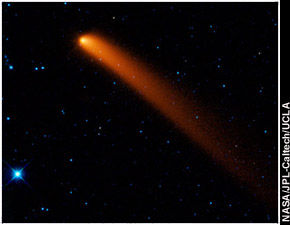
© NASA/JPL-Caltech/UCLA
The
Streak NASA's new Wide-field Infrared Survey Explorer (WISE) spacecraft
is mapping the sky like never before. Among its first images is Comet
Siding Spring, which flashes across the sky impressively in this
infrared image. Observers in Australia discovered the comet, also known
as C/2007 Q3, in 2007
The
Streak NASA's new Wide-field Infrared Survey Explorer (WISE) spacecraft
is mapping the sky like never before. Among its first images is Comet
Siding Spring, which flashes across the sky impressively in this
infrared image. Observers in Australia discovered the comet, also known
as C/2007 Q3, in 2007
More Booms Reported Rattling Brunswick County
Wed, 17 Nov 2010 11:41 CST
Star News Online
Brunswick County residents in Bolivia, Oak Island, Holden Beach and
Southport areas reported a series of mysterious booms and rattles
Wednesday morning.
No one seems to have any idea what could be causing the loud noises, but
speculation has ranged from the continental shelf shifting and
earthquakes to military exercises and Seneca Guns, the unexplained
phenomenon that sounds like rolling thunder or distant cannon fire.
Similar noises raised suspicions earlier this month when booms
shook the ground across Southeastern North Carolina. No one knew what to
attribute those sounds to either.
Florida, US: Jet, space junk, or UFO?
Fri, 26 Nov 2010 08:41 CST
MyFox Tampa Bay
Lakeland - Several Polk County viewers called FOX 13 yesterday evening to report something in the sky.
The callers believed the object may have been a meteor or other object entering Earth's atmosphere.
Photos sent by one viewer showed the bright object with some sort of
vapor or smoke trail behind it. They were taken at around 5:45 p.m.
It's not clear if the object was a passenger jet with its exhaust trail
illuminated by the setting sun, or if it was a meteor or piece of space
junk being burned up as it entered the atmosphere.
FOX 13 has been unable to reach any experts who could confirm either theory.
Two weeks ago, video taken by a news helicopter near Los
Angeles created a buzz when it appeared to show a mystery missile being
launched from the Pacific Ocean. The military later determined it was
likely an aircraft's contrail being illuminated by the evening sun.
Comment: Of course, this is the new explanation
for anything leaving a fiery trail - aircraft's contrail being
illuminated by the setting sun. Not that it hasn't happened, it is just
that this has become an all-too-useful easy explanation for anything
else that may be causing a smokey trail.
How About This Theory: Villa Rica Bang Was a Meteor?
Was it a meteor?
How about two?
The mysterious big bang that has been the talk of Villa Rica and the
surrounding three-county area since it occurred Friday night is still
unexplained, though some think they know what it was and others say it
wasn't the first unexplained sound in the area.
Some people have contacted the AJC saying they saw a large
meteor around the same time as the noise, and others say a meteor can
make a sonic boom if it gets close enough to the ground.
But if that's what made the loud sound heard in Carroll, Douglas and
Haralson counties around 9:45 p.m., then what caused a similar noise two
weeks earlier?
Several people have contacted the AJC to say that the recent explosion was preceded by a slightly quieter one on, or around, Nov. 13.
"It's so weird," said Sandra Harper, who lives in the Mirror
Lake subdivision in Villa Rica, which was apparently ground zero for the
latest blast. "Everybody got in a stew about this one but there was
apparently no stew about the first one."
Harper said both explosions were hearty enough to rattle the windows on
her home. After the first one, she ran to her deck, imagining that a
house in the neighborhood had blown up from an ignition of natural gas.
She looked for smoke and waited for sirens. But when she saw and heard
nothing, she went back inside. No one but her husband mentioned to her
that they had heard it.
The next boom two weeks later caught the attention of far more people, it seems.
Douglas County Communication Director Wes Tallon said last weekend that
"911 calls lit up" the switchboard after it shook houses across west
Georgia.
Villa Rica authorities dispatched several police and fire units to the
Mirror Lake neighborhood when the sound was first reported, but they
found no smoke or damage.
Local authorities speculated that it was a sonic boom made by an
aircraft exceeding the speed of sound, 761 mph. But a Federal Aviation
Administration spokeswoman told the AJC that no commercial aircraft can
travel that fast. Only military airplanes can make a sonic boom, and
there are no military flight zones in the vicinity of the explosion and
there was no record of military flights there at the time, said the FAA
spokeswoman, Kathleen Bergen.
An avid star gazer who contacted the AJC said some meteors that
made it close enough to earth could make a sonic boom. But given the
relatively cloudless skies around the time of Friday's explosion, people
should have seen it, Michael Covington, an amateur astronomer who has
published several books about sky-watching, told the AJC last weekend.
"A really big meteor can make a sonic boom, but if it did, it would make
a big flash of light," said Covington, who helps run a computer
research program at the University of Georgia when he's not pursuing his
hobby.
The local authorities didn't mention any reports of flashes overhead, but several people from the area have contacted the AJC saying they saw a bright light in the sky around the time of the explosion.
"It just looked like a big white ball," said Susan Burns, who lives on a
sparsely populated ridge in south Paulding County. It was mottled,
white and gray, like the moon, and it had a long tail, she said. "It was at least 10 times bigger than any other shooting star I've ever seen."
Burns lives near the Douglas County line and said the meteor appeared to
fall straight down, to the west of her, and to the north of the Mirror
Lake neighborhood. It was around 9:30 p.m. or 9:40 p.m., she recalled.
She found Covington after reading his comment in the AJC. They
communicated by e-mail, and he told her that she must have seen the
source of the explosion. It's possible that she wouldn't have heard
anything because of the meteor's trajectory, he explained.
So maybe that's what happened. And maybe, in a freak coincidence,
another big meteor fell in the same way, in the same place, unnoticed,
two weeks earlier.
Or maybe there is still some other explanation out there.
Maybe it was a military pilot "who was having fun and not telling anybody," speculated Harper, the Mirror Lake resident.
Whatever it was, she said she hopes it doesn't return:
"I'll be concerned if, in two weeks, I hear the same sound again."
Comment: The Mirror Lake resident may have reason to be concerned:
See: Forget About Global Warming: We're One Step From Extinction!
US: Mystery Object Streaks Across The Sky
It was a bird. It was a plane. Or maybe there was just something wrong with the video camera.
You decide.
A DeKalb County man happened to have a camera rolling when what looks
like a fireball floated in the sky overhead last week. Or maybe it was
just an optical illusion created by a passing aircraft.
Charsign Raymond, of Clarkston, was visiting a friend's apartment just
west of downtown Stone Mountain when his friend's wife happened to drive
up.
"She ran in and said, 'Look, you've all got to see this," Raymond recalled.
Raymond, 39, had been playing with his video recorder, and he got out of
the apartment in time to capture whatever it was in the sky.
It looks like a double-barreled ball of fire falling toward earth.
Raymond contacted the AJC last weekend with his find and later loaned a reporter his videotape so the AJC could publish it here.

© Charsign Raymond / Special
Charsign
Raymond, 39, points at the spot in the sky where he saw a mysterious,
burning object at around 5:30 p.m. on Nov. 28. He videotaped it from
near where he was standing, outside an apartment near Memorial Drive and
James B. Rivers Memorial Drive in Stone Mountain. The object was to the
southwest.
Charsign
Raymond, 39, points at the spot in the sky where he saw a mysterious,
burning object at around 5:30 p.m. on Nov. 28. He videotaped it from
near where he was standing, outside an apartment near Memorial Drive and
James B. Rivers Memorial Drive in Stone Mountain. The object was to the
southwest.
On Monday, a reporter visited the site where Raymond shot the video.
The apartment is off the intersection of Memorial Drive and James B.
Rivers Memorial Drive. Raymond's camera was aimed at the southwestern
sky.
The DeKalb County Police Department had no reports of fireballs hitting the county recently.
Mekka Parish, a police department spokeswoman, said she probably would have heard about it if one had.
"Interesting, but I didn't hear a rumor about something like that," she told the AJC on Monday.
This incident, which occurred at around 5:30 p.m. on Nov. 28, is about
as strange as the unexplained explosion that rocked Villa Rica west of
Atlanta two days earlier.
People in three counties -- Carroll, Douglas and Haralson -- complained
about hearing a loud boom around 9:45 p.m. on Nov. 26. Police officers
and firefighters responded to the Mirror Lake neighborhood in Villa
Rica, but found nothing -- not even smoke -- that would indicate
something had exploded.
Authorities there later guessed that the noise had been a sonic boom,
but the Federal Aviation Administration said there were no commercial
aircraft fast enough to produce such a noise. An agency spokeswoman said
that, as far as the FAA knew, military aircraft that could produce a
sonic boom were not flying over the area.
After the AJC published an article about the explosion, readers contacted an AJC
reporter to say that they'd seen a bright light in the sky around that
time. A woman in Paulding County near the Douglas County line said it
was a meteor about 10 times larger than any she'd ever seen.
But if a meteor explained that noise, what explained the noise that
others heard two weeks earlier? Several readers said they'd heard a
quieter explosion around Nov. 13.
The Rupununi Event
Mon, 06 Dec 2010 14:32 CST
Cosmic Tusk
I
now move on to the suspected explosion over British Guyana in 1935. The
main source for information on this event is a story entitled Tornado
or Meteor Crash? in the magazine The Sky (the forerunner of Sky and Telescope)
of September 1939(5). A report from Serge A. Korff of the Bartol
Research Foundation, Franklin Institute (Delaware, USA) was printed, he
having been in the area - the Rupununi region of British Guyana - a
couple of months later. The date of the explosion appears to have been
December 11, 1935, at about 21h local time. I might note that this is
near the date of the peak of the Geminid meteor shower, but yet again
this may be merely a coincidence. The location is given as being near
Lat: 2 deg 10min North, Long: 59 deg 10 min West, close to Marudi
Mountain.
Korff's description suggested that the region of devastation might be
greater than that involved in the Tunguska event itself. On his
suggestion, a message was sent to William H. Holden, who in 1937 was in
the general region with the Terry-Holden expedition of the American
Museum of Natural History. That group hiked to the top of Marudi
Mountain in 1937 November and reported seeing an area some miles across
where the trees had been broken off about 25 feet above their bases,
although regrowth over two years in this tropical jungle had made it
difficult to define the area affected. Holden confirmed, on returning to
New York, that he believed the devastation was due to an atmospheric
explosion of cosmic origin. An explorer and author, Desmond Holdridge,
also visited the region in the late 1930′s and confirmed the suspicion
that a comet or asteroid detonation was responsible.
Korff obtained several local reports, the best being from a Scottish
gold miner, Godfrey Davidson, who reported having been woken by the
explosion, with pots and pans being dislodged in his kitchen, and seeing
a luminous residual trail in the sky. A short while later, whilst
prospecting, he cam across a devastated region of the jungle he
estimated to be about five by ten miles (8 by 16 kilometers), with the
trees all seeming to have been pushed over.
Holden was unsure of the origin of the flattening of the forest, and
pointed out that similar destruction can result from tornados.
Holdridge, however, reported eye-witness accounts in accord with a large
meteoroid/small asteroid entry, with a body passing overhead
accompanied by a terrific roar (presumably electrophonic effects), later
concussions, and the sky being lit up like daylight. A local aircraft
operator, Art Williams, reported seeing an area of forest more than
twenty miles (32 kilometers) in extent which had been destroyed, and he
later stated that the shattered jungle was elongated rather than
circular, as occurred at Tunguska and would be expected from the air
blast caused by an object entering away from the vertical (the most
likely entry angle for all cosmic projectiles is 45 degrees).
There is a report of the Guyanan event, largely derived from the account in The Sky,
in the newsletter Meteor News for March 1974. Apparently as a result of
that, the publishers (Karl and Wanda Simmons, of Callahan, Florida) had
some correspondence with a Mr. F.A. Liems of Paramaribo, Surinam,
concerning a possible crater/event at Wahyombo in that country; he gives
the location as Lat: 5.25 deg North, Long: 56.05 deg West. The letters
date from 1976; apparently Liems died in 1982. In 1990, as a result of
Andreev's article in WGN about the Brazilian event, Wanda Simmons sent
copies to him, and he kindly sent copies on to me. Various
notes/maps/letters are included, but it is difficult to know what to
make of them: my impression is that this concerns something that
occurred some time ago, not in this century, and it's linkage with an
incursion by an asteroid or comet is far from clear.
Source
Geminid Meteor Shower Defies Explanation
The Geminid meteor shower, which peaks this year on Dec. 13th and
14th, is the most intense meteor shower of the year. It lasts for days,
is rich in fireballs, and can be seen from almost any point on Earth.
It's also NASA astronomer Bill Cooke's favorite meteor shower - but not for any of the reasons listed above.
"The Geminids are my favorite," he explains, "because they defy explanation."
Most meteor showers come from comets, which spew ample meteoroids for a
night of 'shooting stars.' The Geminids are different. The parent is not
a comet but a weird rocky object named 3200 Phaethon that sheds very
little dusty debris - not nearly enough to explain the Geminids.
"Of all the debris streams Earth passes through every year, the
Geminids' is by far the most massive," says Cooke. "When we add up the
amount of dust in the Geminid stream, it outweighs other streams by
factors of 5 to 500."
This makes the Geminids the 900-lb gorilla of meteor showers. Yet 3200 Phaethon is more of a 98-lb weakling.
3200 Phaethon was discovered in 1983 by NASA's IRAS satellite and
promptly classified as an asteroid. What else could it be? It did not
have a tail; its orbit intersected the main asteroid belt; and its
colors strongly resembled that of other asteroids. Indeed, 3200 Phaethon
resembles main belt asteroid Pallas so much, it might be a 5-kilometer
chip off that 544 km block.
"If 3200 Phaethon broke apart from asteroid Pallas, as some
researchers believe, then Geminid meteoroids might be debris from the
breakup," speculates Cooke. "But that doesn't agree with other things we
know."
Researchers have looked carefully at the orbits of Geminid meteoroids
and concluded that they were ejected from 3200 Phaethon when Phaethon
was close to the sun - not when it was out in the asteroid belt breaking
up with Pallas. The eccentric orbit of 3200 Phaethon brings it well
inside the orbit of Mercury every 1.4 years. The rocky body thus
receives a regular blast of solar heating that might boil jets of dust
into the Geminid stream.
Could this be the answer?
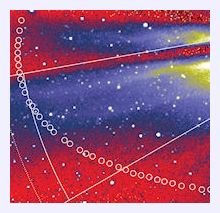
© NASA
The path of 3200 Phaethon through STEREO's HI-1A coronagraph camera. False-color green and blue streamers come from the sun.
The path of 3200 Phaethon through STEREO's HI-1A coronagraph camera. False-color green and blue streamers come from the sun.
To
test the hypothesis, researchers turned to NASA's twin STEREO
spacecraft, which are designed to study solar activity. Coronagraphs
onboard STEREO can detect sungrazing asteroids and comets, and in June
2009 they detected 3200 Phaethon only 15 solar diameters from the sun's
surface.
What happened next surprised UCLA planetary scientists David Jewitt and
Jing Li, who analyzed the data. "3200 Phaethon unexpectedly brightened
by a factor of two," they wrote. "The most likely explanation is that
Phaethon ejected dust, perhaps in response to a break-down of surface
rocks (through thermal fracture and decomposition cracking of hydrated
minerals) in the intense heat of the Sun."
Jewett and Li's "rock comet" hypothesis is compelling, but they point
out a problem: The amount of dust 3200 Phaethon ejected during its 2009
sun-encounter added a mere 0.01% to the mass of the Geminid debris
stream - not nearly enough to keep the stream replenished over time.
Perhaps the rock comet was more active in the past ...?
"We just don't know," says Cooke. "Every new thing we learn about the Geminids seems to deepen the mystery."
This month Earth will pass through the Geminid debris stream, producing
as many as 120 meteors per hour over dark-sky sites. The best time to
look is probably between local midnight and sunrise on Tuesday, Dec.
14th, when the Moon is low and the constellation Gemini is high
overhead, spitting bright Geminids across a sparkling starry sky.
Bundle up, go outside, and savor the mystery.
Asteroid Early Warning System Proposed
Mon, 06 Dec 2010 16:08 CST
King 5 News
Seattle - The leading proponent of an asteroid early warning
system reportedly says it could give Earth at least a week's notice
before the rock capable of catastrophic damage would make impact.
What would it do for mankind? It certainly wouldn't be enough time to
launch a mission to deflect the space rock, since the technology for
that doesn't exist. But, it would allow authorities time to evacuate the
predicted impact area, such as a city.
According to an article
on Space.com, the proposed network, called the Asteroid
Terrestrial-impact Last Alert System (ATLAS), would consist of two
observatories about 60 miles apart. They would scan the visible sky
twice each night. They would help pinpoint the location and time of
impact.
Astronomer John Tonry at the University of Hawaii is the leading
proponent of the system. He says ATLAS would cost $1 million per
observatory, plus $500,000 annually to staff them.
Tonry points to a near-miss in Oct. 2009 as the reason such a
system is needed. A 33-foot-long rock exploded as it entered Earth's
atmosphere over Indonesia. The blast purportedly was three times the
power of the atomic bomb dropped on Hiroshima. Nobody was hurt.
In 1908, a roughly 160-foot long asteroid impacted the Tunguska area of
Russia. Something that size is likely to hit Earth about once every
1,000 years. The National Research Council says an object that size
could kill 30,000 people on average.
Tonry says ATLAS could detect roughly 75 percent of the sky. It would
provide three weeks' warning for 460-foot-long objects and one week's
notice for 160-foot-long objects. Asteroids like the one that exploded
over Indonesia last year might give one day's warning.
Atlanta, US: Mysterious fireball streaking across the sky leaves onlookers bewildered
Tue, 07 Dec 2010 07:21 CST
The Daily Mail
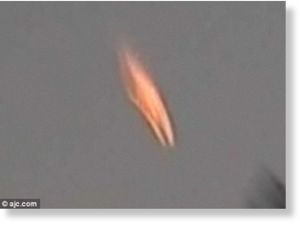
© ajc.com
Unexplained: A mysterious fireball streaked across the sky over Atlanta leaving onlookers bewildered
Unexplained: A mysterious fireball streaked across the sky over Atlanta leaving onlookers bewildered
A mysterious fireball that lit up the sky over Atlanta has left onlookers bewildered as to what it could have been.
Charsign Raymond, 39, of Clarkston, was visiting a friend's home in
Stone Mountain when his friend's wife saw the unidentified object streak
across the sky.
'She ran in and said, "Look, you've all got to see this"', Mr Raymond recalled.
Mr Raymond managed to capture the double-barrelled ball of fire falling towards the ground on his camera.
DeKalb
County Police Department said they had no reports of fireballs hitting
the county recently and have offered no explanations as to what it could
be.
A neighbour who also witnessed the unexplained sighting said she thought
it was a meteor about 10 times larger than any she'd ever seen before.
A second streak zoomed across the sky just seconds later.
The
strange incident happened around 5.30pm on November 28. Just two days
earlier an unexplained explosion rocked Villa Rica west of Atlanta.
People in three counties - Carroll, Douglas and Haralson - complained about hearing a loud boom late on November 26.
Police officers and firefighters responded to the Mirror Lake neighbourhood but found nothing.
There was no smoke or anything that would indicate something had
exploded despite the numerous calls they received about the loud bang.
Authorities suggested the noise had been a sonic boom, but the Federal
Aviation Administration said there was no commercial aircraft fast
enough to produce such a sound.
UK: Meteor Fireball Spotted in Skies Over Britain
Wed, 08 Dec 2010 17:43 CST
BBC
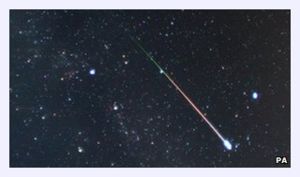
© Pete Lawrence
Meteor showers, like this one over the UK in 2009, are eagerly sought out by stargazers.
Meteor showers, like this one over the UK in 2009, are eagerly sought out by stargazers.
Stargazers throughout the UK have reported seeing a meteor-like streak of light in the darkened skies.
The BBC was contacted by people in Scotland, the Midlands, Wales, and
northern and south west England who saw the display at about 1740 GMT.
One witness driving home from work in Coventry said the light was a bit scary because it was so "incredibly bright".
Astronomers said the brightness of the meteor, a chunk of space rock burning up in the atmosphere, was unusual.
Dr David Whitehouse. astronomer and former BBC correspondent, said:
"It's a bright meteor called a fireball, extraordinarily bright.
"This a chunk of space rock perhaps the size of your fist, perhaps a bit
larger, that is burning up as it comes through our atmosphere at an
altitude of 60 or 70 miles or so.
'Spectacular'
"So it sounds extraordinary if you're very lucky enough to have seen it; it's quite rare."
Tina Baxter was driving home when she spotted the meteor-like streak.
She told the BBC: "It was heading north and it appeared directly in front of me. It was travelling east to west.
"At first I thought it was a firework, but it was travelling at a funny angle - across then down.
"It was a bit scary because it was so massive and incredibly bright.
When I got home, my brother was there, and he said he saw it as well.
"I would be surprised if anyone took pictures of it - it appeared for three seconds and then it was gone."
Keith Levitt, 67, from Aberffraw on Anglesey, said he went outside to
empty shopping from the boot of his car at about 1740 GMT when he saw a
bright light above.
He told the BBC: "Initially, I thought it was the light from a plane,
then I suddenly realised it was a ball with bits coming away from it. I
realised it was a meteor.
"It was a large object, I only saw it for two or three seconds. It was going in a low trajectory then petered out into nothing.
"I've never seen anything so large and so close. I've seen shooting
stars but this was quite spectacular because it was so large."
Did you see the meteor? Send us your comments and experiences using the form below.
Massive dark object 'lurking on edge of solar system hurling comets at Earth'
Wed, 08 Dec 2010 15:12 CST
Daily Mail
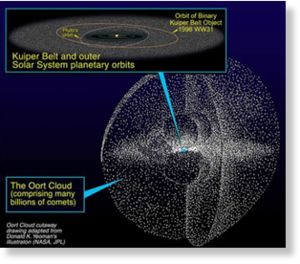
© Donald K. Yeoman/NASA, JPL
A
Nasa graphic which illustrates how the Oort Cloud surrounds our solar
system. Scientists believe that an object with a huge mass may be
pushing comets towards Earth from the cloud
A
Nasa graphic which illustrates how the Oort Cloud surrounds our solar
system. Scientists believe that an object with a huge mass may be
pushing comets towards Earth from the cloud
A massive dark object may be lurking on the edge of our solar system, according to scientists.
Most comets that fly into the inner solar system seem to come from the
outer region of the Oort cloud - a region of icy dust and debris left
over from the birth of the solar system.
The cloud starts from a point about 93 billion miles from the Sun and
stretches for around three light years and contains billions of comets,
most of them small and hidden.
Now new calculations suggest a large object that
is up to four times as big as Jupiter could be responsible for sending
them in our direction.
The scientists have analysed the comets in the Oort cloud and deduced
that 25 per-cent of them would need a nudge by a body of at least
Jupiter size before they changed orbit.
Astrophysicists John Matese and Daniel Whitmire at the University of
Louisiana came up with theory said that "something smaller than a Jovian
mass would not be strong enough to perform the task".
They believe that our solar system has a hidden 'companion' that has so far remained undetected.
The scientists have been studying the cloud using WISE, Nasa's infra-red
space telescope that is capable of detecting dark objects.
Matese said: 'I think this whole issue will be resolved in the next five
to 10 years, because there's surveys coming on line that will dwarf the
comet sample we have today.
"Whether these types of asymmetries in the directions that comets are
coming from actually do exist or not will definitely be hammered out by
those surveys." Matese added. "We anticipate that WISE is going to
falsify or verify our conjecture."
About 3,200 long-period comets are known, one of the most famous being
Hale-Bopp which was visible to even the naked eye during 1996 and 1997.
Halley's Comet, which reappears about every 75 years, is a
'short-period' comet from a different part of the Solar System called
the Kuiper Belt.
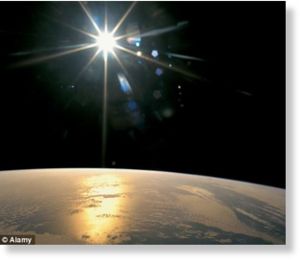
© Alamy
A large planet that is in orbit outside the solar system may be pushing comets towards Earth.
A large planet that is in orbit outside the solar system may be pushing comets towards Earth.
If it exists the new planet is so freezing cold it is difficult to spot, researchers said.
It could be found up to 30,000 astronomical units from the sun. One AU
is the distance between the Earth and the sun, about 93 million miles.
Scientists have already proposed that a hidden star, which they call Nemesis, might exist a light-year or so away from our sun.
They suggest that during its orbit it would regularly enter the Oort
cloud, jostling the orbits of many comets there and causing some to fall
toward Earth.
These occasional comet showers could be why the mass extinctions on Earth are so regular, some scientists believe.
The research appeared in the online edition of the journal Icarus.
"Most planetary scientists would not be surprised if the largest
undiscovered companion was Neptune-sized or smaller, but a Jupiter-mass
object would be a surprise," Matese told SPACE.com
"If the conjecture is indeed true, the important implications would
relate to how it got there - touching on the early solar environment -
and how it might have affected the subsequent distributions of comets
and, to a lesser extent, the known planets."
U.S. Military in Talks to Share Fireball Data from Secret Satellites
For decades, the U.S. Department of Defense has operated classified
spacecraft loaded with high-tech gear to carry out a range of
reconnaissance duties. But the satellites have also spotted the
high-altitude explosions of natural fireballs that routinely dive into
the Earth's atmosphere, and talks are under way to offer scientists
access to that data.
In the past, the data on the fireballs, caused by small asteroids called
bolides, was shared with the near-Earth object (NEO) science community,
information deemed ideal for understanding the size of small NEOs and
the hazard they pose.
From space scientists, they stress that such data sharing is also
important for validating airburst simulations, characterizing the
physical properties of small NEOs - such as their strength - and
assisting in the recovery of meteorites.
On the other hand, the message from U.S. military and intelligence
officials is that they worry about release of sensitive data gleaned by secret satellites.
'The bolide thing'
A delicate dance is under way between the U.S. military and scientists
to put in place a partnership focused on fireballs - but there are a
number of thorny issues on the table.
"We are working it," said Robert Rego, now chief of Space and Cyberspace
Operational Integration at Peterson Air Force Base in Colorado Springs,
home of the Air Force Space Command.
"I would say that we're working it, not from the perspective of 'no and
how we can't do it'...but from 'yes, and how we can do it' and make it
beneficial while still protecting a space capability," Rego told
SPACE.com in an exclusive interview.
A former brigadier general, Rego transitioned last October to a U.S. Air
Force civilian position. Since that time, "we've re-energized what
we're thinking here," Rego said, noting that it's still referred to "as
the bolide thing."
Rego said that from the sensor development community perspective,
"there's a wide variety of folks that play in that ... some that we can
talk about, some that we can't."
The thinking today centers on figuring out the what, in terms of data
release, Rego said. "That's been a tad contentious," he said, "but we
think we've got a data set now that's valuable, as well as agreed upon
in terms of releasability."
Following an observed incoming bolide by a space-based asset, date and
time of the event, location, altitude, the estimated velocity of the
object, as well as the approximate total radiated energy would be made
available, Rego said.
Furthermore, an assessment of the type of event - whether or not the
activity is based upon a comet or an asteroid - can be provided, he
said.
"We think that [these factors] give a good balance between what's valuable for the researchers and what protects the capability of our space systems," Rego added. This policy would be put in place, he said, from a U.S. Air Force perspective.
Fireball data dictionary
But still to be settled is the how the military will distribute the data.
"Sort of who does it, how do we do it?" Rego pointed out. "How do you
make data available for a variety of users, for a variety of reasons?
That data exposure is something that we're wrestling with here."
Rego said that a "data dictionary" - agreement on terms, methods, the
meaning of words - is also part of the dialogue on data exposure.
In looking for models to push forward on bolide data-sharing with scientists, Rego pointed to the government's Space Situational Awareness Sharing Program.
It provides tracking data on the whereabouts of space objects with
various entities - including commercial space players - to help
prevent satellite collisions and from trashing the Earth's orbit even
more.
Another possible model, Rego said, is the Civil Applications Committee
(CAC), an interagency committee that coordinates and oversees the
federal use of classified collections.
In recent years, CAC activities have expanded beyond traditional mapping
applications to a broad range of environmental and remote sensing
applications central to federal agency missions.
Examples include monitoring volcanoes; detecting wildland fires; coordinating emergency response to natural disasters, such as hurricanes, earthquakes, and floods; monitoring ecosystems, and mapping wetlands.
"So we're looking there," Rego said. "I'd be the last guy on the planet
to put a clock on this thing," admitting that he was "dramatically
optimistic" when interviewed last year for SPACE.com.
Migration to newer systems
Yet another piece of Rego's on-going look into bolide data-sharing is resources.
"This would be a new effort," he said, although not likely something that breaks the bank.
"But it will take an amount of resources, either dollars or people to
set it up and make sure that the outcome is not unduly biased by a poor
set-up," Rego said.
Given that space-based assets used to support scientific bolide
investigations are aging, is migration of this data sharing to newer
space systems in the cards?
"The fundamental answer is yes, Rego said. "We don't anticipate putting
this effort in place and then have it dwindle to nothing as vehicles age
out."
Study recommends NEO data dumps
Mark Boslough, a physicist at Sandia National Laboratories in
Albuquerque, N. M., served on the mitigation panel of a National
Research Council committee that reviewed NEO surveys and hazard
mitigation strategies.
The NRC report, called "Defending Planet Earth: Near-Earth Object
Surveys and Hazard Mitigation Strategies," was issued last January. It
outlined options NASA could follow to detect more NEOs, asteroids and
comets that could pose a hazard if they cross Earth's orbit.
That NRC assessment made a number of high-level recommendations.
"Data from NEO airburst events
observed by the U.S. Department of Defense satellites should be made
available to the scientific community to allow it to improve
understanding of the NEO hazards to Earth," the report stated.
Boslough said that being a member of the scientific and national
security communities, he felt he could offer both perspectives, as he
views them.
Impact risk to Earth
"There are legitimate national security reasons for some restrictions on
data release, but these data are extremely valuable to the scientific
community in our effort to understand and quantify the impact risk and
to develop the most effective mitigation plan against airbursts,"
Boslough told SPACE.com.
Boslough said that another airburst like the 1908 Tunguska event is, by far, the most likely threat from asteroids in our lifetimes.
"Satellite-based observations allow us to better understand the physics
and damage potential of dangerous airbursts, and to better estimate
their likelihood and risk," Boslough said. "Even if the raw data remain
classified at a higher level than scientists want, I hope that there
will be a mechanism that will allow us to release other information
based on the classified data."
Longer observation times will provide more statistics, Boslough added,
allowing researchers to refine the power-law size distribution - which
by itself is immensely useful for both risk assessment and basic
science, he said, but doesn't necessarily require open release of the
raw data for every bolide detection.
"It is always better for science when data are openly available for
independent scrutiny, but sometimes a balance must be struck between
openness and security. I would like to see the balance account for the
scientific value of the data," Boslough concluded.
Unmatched data source
Bolide experts also covet the sheer wealth of data on NEO airbursts that are routinely recorded by military assets in orbit.
"From past experience working with U.S. government satellite data, the
information provided is unmatched by any other data source and allows
scientific analyses which are otherwise impossible," said Peter Brown, a
research scientist specializing in meteors, meteorites, meteoroids and
asteroids at the University of Western Ontario in London, Ontario,
Canada.
Brown is also a core faculty member of the university's meteor physics
group within the department of physics and astronomy. On the group's
website there's an archive of past fireball measurements with sources to
the U.S. Department of Defense, the U.S. Air Force and Sandia National
Laboratories - data derived from optical and infrared sensors aboard
U.S. satellites.
But the list ends with a U.S. report of a bolide detonating at 23 statute miles (37 kilometers) over Africa on Oct. 7, 2008.
"The science community remains eager to get this information," Brown told SPACE.com.
With NEO airburst data, he said, it allows scientists to advance the understanding of NEO hazards to our planet.
Asteroid Scheila Sprouts a Tail and Coma
When is an asteroid not an asteroid? When it turns out to be a
comet, of course. Has this ever happened before? Why, yes it has. In
fact it was just announced December 12, 2010 that the asteroid (596)
Scheila has sprouted a tail and coma! This is likely a comet that has
been masquerading as an asteroid.
Steve Larson of the Lunar and Planetary Laboratory (LPL), University of
Arizona first reported that images of the minor planet (596) Scheila
taken on December 11th showed the object to be in outburst, with a
comet-like appearance and an increase in brightness from magnitude 14.5
to 13.4. The cometary appearance of the object was confirmed be several
other observers within hours.
A quick check of archived Catalina images of Scheila from October 18,
November 2 and November 11 showed Scheila to look star-like, which is
what asteroids look like from Earth. They just happen to be moving
across the field of view in contrast to the fixed background stars. The
image taken by Catalina on December 3rd shows some slight diffuseness
and an increase in overall brightness. So, it appears this even began on
or around December 3rd.
Upon hearing the news, there was some speculation that this might be
evidence of an impact event. Had something crashed into asteroid
Scheila? It seems unlikely, and this is a story we have heard before.
The asteroid discovered in 1979 and named 1979 OW7 was lost to
astronomers for years and then recovered in 1996. It was subsequently
renamed 1996 N2. That same year it was discovered to have a comet-like
appearance, and many believed this was the signature of an impact
between two asteroids. After years of inactivity 1996 N2 sprouted a tail
again in 2002. One collision between two asteroids was unlikely enough.
The odds of it happening again to the same object were essentially
zero. What we had was a comet masquerading as an asteroid. This object
is now known by its cometary name 133P/Elst-Pizarro, named after the two
astronomers who discovered its initial cometary outburst.
The 2002 outburst and the discovery of more active asteroids showing mass-loss led to a paper (Hsieh and Jewitt 2006, Science, 312, 561-563)
introducing an entirely new class of solar system objects, Main Belt
Comets (MBC). MBCs look like comets because they show comae and have
tails but they have orbits inside Jupiter's orbit like main belt
asteroids.
The most likely cause of the mass loss activity in MBCs is sublimation
of water ice as the surface of the MBC is heated by the Sun. This is
suggested most strongly by the behavior of the best-studied example,
namely 133P/Elst-Pizarro. Its activity is recurrent, and it is strongest
near and after perihelion, the point in its orbit nearest the Sun, like
other comets.
MBCs are interesting to astronomers because they appear to be a third
reservoir of comets in our solar system, distinct from the Oort cloud
and Kuiper belt. Since we know of no way for theses other reservoirs to
have deposited comets in the inner solar system, the ice in MBCs
probably has a different history than the ice in the outer comets. This
allows researchers to study the differences in the Sun's proto-planetary
disk at three separate locations. This might lead to information on the
Earth's oceans, one of the continuing lines of investigation by solar
system scientists.
Now it seems we have another MBC to add to the sample. And Scheila will
probably be getting a new name soon. Asteroid (596) Scheila was
discovered Feb. 21, 1906, by A. Kopff at Heidelberg. The 113Km in
diameter 'asteroid' was named after an acquaintance, an English student
at Heidelberg. In the future it will be called XXXP/Lawson or something
similar, and Kopff's Scheila will become just another footnote in the
history of astronomical nomenclature.
Geminid Meteor Shower Tonight
Mon, 13 Dec 2010 11:43 CST
Space Weather
The Geminid meteor shower is underway. According to the International
Meteor Organization, dark-sky observers are now counting as many as 40
Geminids per hour. Forecasters expect this rate to double or more when
the shower peaks during the early hours of Dec. 14th. The best time to
look is during the dark hours before sunrise on Tuesday: sky map.
Here is a selection of early Geminids photographed on Monday, Dec. 13th: #1, #2, #3, #4.
Plan B: Got clouds? You can listen to Geminid radar echoes on Space Weather Radio.
Russian scientists have discovered a first comet over the last 20-year period
Mon, 13 Dec 2010 14:55 CST
Russia-IC
Russian scientists have discovered a first comet over the last 20-year period.
The new comet, now marked as C/2010 X1 (Elenin), was discovered by an
astronomer Leonid Elenin from the Institute of Applied Mathematics on
December 10, 2011. The discovery was made by means of a Russian
automated observatory ISON-NM, located in New Mexico, USA.
Following day has brought confirmation of the comet's existence
from Russian and Ukrainian astronomers, working at Maidanak
observatory, Kazakhstan. American and Japanese scientists have sent
their confirmations one day later.
Parameters of the new celestial body need to be measured more accurately.
Flashback:
The Day the Earth Froze: Younger Dryas Ice Age caused by Storm of Comet Debris
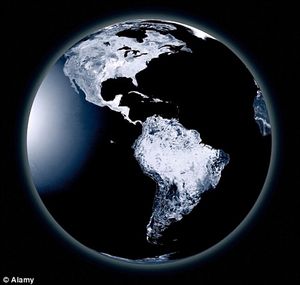
© Alamy
"New" theory: An hour-long hailstorm from space bombarded the Earth 13,000 years ago - plunging the planet into a mini-ice age
"New" theory: An hour-long hailstorm from space bombarded the Earth 13,000 years ago - plunging the planet into a mini-ice age
An
hour-long hailstorm from space bombarded the Earth 13,000 years ago -
plunging the planet into a mini-ice age, scientists claimed today.
The catastrophe was caused by a disintegrating comet and saw the planet
sprayed by thousands of frozen boulders made of ice and dust.
The collisions wiped out huge numbers of animal species all over
the world, disrupted the lives of our stone age ancestors and triggered
a freeze that lasted more than 1,000 years.
The theory is the brainchild of Professor Bill Napier, from Cardiff
University, who says it explains the mysterious period of extinction
around 11,000 BC.
Scientists have long been puzzled by what caused a sudden cooling of up
to 8C (14F) just as the Earth was warming up at the end of the last ice
age.
The change in climate caused retreating glaciers to advance once again,
and coincided with the extinction of 35 families of North American
mammals.
Some geologists have argued that the world was hit by a giant
asteroid - a smaller version of one which wiped out the dinosaurs 65
million years ago.
The collision left behind tell-tale traces in the rocks - including a
black 'mat' of soot an inch thick thought to have been created by
continental wide wildfires.
Microscopic 'nanodiamonds' created in massive shocks and only found in
meteorites or impact craters have also been discovered dating back to
the disaster.
These findings have led to claims that a 2.5 mile long comet or asteroid
smashed into the ice sheet covering what is now Canada and the northern
US.
But other scientists say the chances of the Earth being struck by such a
large object only 13,000 years ago are one thousand to one against. And
they say a single impact cannot explain such widespread fires.
Professor Napier's theory suggests the devastation took place
when the Earth strayed into a dense trail of fragments shed by a large
comet.
Thousands
of chunks of material from the comet would have rained down on Earth,
each one releasing the energy of a one megaton nuclear bomb.
The impacts would have filled the atmosphere with smoke and soot and blotting out the Sun.
Prof Napier says a comet swooped into the inner solar system between
20,000 and 30,000 years ago and has been breaking apart ever since.
'A large comet has been disintegrating in the near-Earth environment for
the past 20,000 to 30,000 years and running into thousands of fragments
from this comet is a much more likely event than a single collision,'
said Professor Napier.
His model, published in the journal Monthly Notices of the Royal Astronomical Society, suggests that the 'hailstorm' would have only lasted about an hour.
It would have caused thousands of impacts, generating global fires and
depositing nanodiamonds at the 'extinction boundary' marking the point
in time when many species died out.
One recent impact that may have come from the comet is known as the Tagish Lake meteorite, said Professor Napier.
The object fell on Yukon Territory in Canada in January 2000. It
contained the largest amount of nanodiamonds of any meteorite studied so
far.
Comment: Finally, some mainstream verification of what Sott.net has been saying for years is coming through the information blackout. In February media outlets carried reports that a swarm of comet debris may have caused the 'Dark Ages' circa 500 AD. Bill Napier, as well as Victor Clube, deserve major recognition for their dedication in putting many of the puzzle pieces together. The Cycle of Cosmic Catastrophes by Firestone, West and Warwick-Smith is the seminal book on this cometary bombardment, the Younger Dryas Impact Event, at the end of the last Ice Age.
Besides older comets that break up and leave debris trails through which the Earth periodically passes, Laura Knight-Jadczyk's tireless research
has led us to consider the cyclical mechanism by which comets from the
Oort Cloud surrounding the outer solar system are knocked into the inner
solar system by the return of the Sun's dark star companion, 'Nemesis.'
We've been observing the steady increase in the number of fireball sightings, the cooling of the upper atmosphere, strange cloud formations and recent comet impacts on other planets in our solar system. Taken with research which reveals that our environment is constantly affected by interaction with comet dust (sometimes laden with larger fragments) and cosmic radiation,
we've deduced that our Big Blue Marble is once again on the threshold
of encountering a cosmic storm. In fact, it's overdue for the Perfect
Storm as several cycles return together.
For more in-depth reading, see Laura Knight-Jadzyck's article
Meteorites, Asteroids, and Comets: Damages, Disasters, Injuries, Deaths,
and Very Close Calls.
Something Wicked This Way Comes, a Sott.net production:
Flashback:
U.S. Must Be Ready to Meet Asteroid Threat, White House Science Adviser Says
National emergency plans for natural disasters can also work in the
unlikely scenario of an asteroid strike on the U.S., according to a
letter to Congress by the White House's top science adviser, SPACE.com
has learned.
The 10-page letter by John Holdren, director of the White House Office
of Science and Technology Policy, adds that the U.S. has a
responsibility to the world as the country most capable of detecting
space rocks that threaten Earth. The Oct. 15 letter obtained by
SPACE.com is addressed to the leaders of the House Committee on Science
and Technology.
Holdren states that NASA must continue leading efforts to close the gap
in detecting and perhaps deflecting near-Earth objects (NEO). The U.S.
space agency already has the duty of alerting the rest of the government
about any threatening space objects.
Holdren's letter also laid out the duties of other federal
agencies in handling emergency communications and response. It called
for a "senior-level interagency simulation exercise" to test
impact-response plans before the United States is confronted with an
actual asteroid impact.
"My immediate reaction is that it represents the most detailed consideration of the U.S. government's response to the NEO threat
to date, more clearly delineating communication links and
responsibilities than had previously been the case," said Clark Chapman,
space scientist at the Southwest Research Institute in Boulder,
Colorado.
Going on alert
According to Holdren's letter, the Federal Emergency Management Agency,
under the Department of Homeland Security, has the main responsibility
on the ground in the U.S. FEMA can rely in part upon the National
Warning System, which was designed to alert U.S. citizens to a Cold War
nuclear attack.
The Department of Defense would work with NASA on possible mitigation or deflection scenarios that involved military resources.
Meanwhile, the Department of State would help coordinate any
international warnings or responses in a deep-impact scenario that
affects more than just the U.S. It has experience notifying other
countries about re-entering human-made space objects, including the defunct USA-193 spy satellite that was ultimately destroyed by a U.S. Navy missile.
"The United States is currently the world leader in NEO detection
activities and will have a vital role to play in such communications,
irrespective of whether the direct risk to the United States or its
territories is considered low," Holdren said.
A NASA advisory council recently suggested that the space agency set up an official Planetary Defense Coordination Office to lead protection efforts against threatening asteroids or comets.
Finding the threat
NASA has begun closing in on its congressionally directed goal of
finding at least 90 percent of all NEOs with a diameter of 1 kilometer
or greater. Search teams had discovered about 903 of an estimated 1,050
NEOs in that size category as of Oct. 1, and the space agency plans to
reach its 90 percent detection goal by the end of this year.
Just 149 of the discovered objects have orbits that could possibly bring
them into collision with Earth, and none present an impact threat
within the next 100 years. Another 993 objects less than one kilometer
in diameter also have orbits that could someday pose a threat to our
planet.
Yet NASA estimates that the 6,416 known NEOs in the smaller size
category, less than 1 kilometer wide, represent just five percent of the
expected count. In other words, there are probably many more objects out there that represent a possible threat to Earth.
Facing the future
Some of those objects were discovered more recently by NASA's
sky-mapping WISE mission, which is slated to end in January 2011. But
there are possible plans for ground-based telescopes that could join the
hunt, such as the Air Force's Space Surveillance Telescope and the
Large Synoptic Survey Telescope.
The National Research Council and NASA also suggested the possibility of a dedicated asteroid hunter that would fly in a Venus-trailing orbit. No firm plans have been made for this.
President Barack Obama's new National Space Policy and plan for human
spaceflight has also targeted a human mission to an asteroid by 2025.
That could prove a useful dry run of sorts for any future efforts that
might need to deflect an asteroid away from Earth.
"The planning, required capabilities, and ultimate execution of such a
mission also would parallel most aspects of a potential robotic
asteroid-deflection mission, providing valuable experience in
asteroid-rendezvous techniques," Holdren said.
Sudan's Nubian desert meteorite just one piece of an unknown celestial body
Wed, 15 Dec 2010 10:32 CST
PhysOrg
Scientists
from all over the world are taking a second, more expansive, look at
the car-sized asteroid that exploded over Sudan's Nubian Desert in 2008.
Initial research was focused on classifying the meteorite fragments
that were collected two to five months after they were strewn across the
desert and tracked by NASA's Near Earth Object astronomical network.
Now in a series of 20 papers for a special double issue of the journal Meteoritics and Planetary Science,
published on December 15, researchers have expanded their work to
demonstrate the diversity of these fragments, with major implications
for the meteorite's origin.
In the first round of research, Carnegie Geophysical scientist Doug
Rumble, in collaboration with Muawia Shaddad of the University of
Khartoum, examined one fragment of the asteroid, called 2008 TC3, and
determined that it fell into a very rare category of meteorite called
ureilites. Ureilites have a very different composition from most other
meteorites. It has been suggested that all members of this meteoric
family might have originated from the same source, called the ureilite
parent body, which could have been a proto-planet.
Now Rumble has expanded his work to examine 11 meteorite fragments,
focusing on the presence of oxygen isotopes. Isotopes are atoms of the
same element that have extra neutrons in their nuclei.
Rumble explains: "Oxygen isotopes can be used to identify the
meteorite's parent body and determine whether all the fragments indeed
came from the same source. Each parent body of meteorites in the Solar
System, including the Moon, Mars, and the large asteroid Vesta, has a
distinctive signature of oxygen isotopes that can be recognized even
when other factors, such as chemical composition and type of rock, are
different."
Rumble and his team prepped tiny crumbs of these 11 meteorite fragments
and loaded them into a reaction chamber where they were heated with a
laser and underwent chemical reactions to release oxygen and then used
another device, called a mass spectrometer, to measure the
concentrations of these oxygen isotopes. Results showed that the full
range of oxygen isotopes known to be present in ureilites were also
present in the studied fragments.
"It was already known that the fragments in the Nubian Desert came from
the same asteroid. Taking that into account, these new results
demonstrate that the asteroid's source, the ureilite parent body, also
had a diversity of oxygen isotopes," says Rumble.
The diversity of oxygen isotopes found in ureilites probably arises from
the circumstances of the parent this body's formation. Rumble theorizes
that the rock components of this parent body were heated to the point
of melting and then cooled into crystals so quickly that the oxygen
isotopes present could not come to an equilibrium distribution
throughout.
Together the collection of 20 papers published in Meteoritics and Planetary Science offer enormous insight about the formation and composition of ureilites and their hypothesized parent body.
Smash Earth on your computer! Website lets you calculate damage from comet or asteroid
Thu, 16 Dec 2010 11:19 CST
MSNBC / SPACE.com
A
new website lets astronomers - and anyone who likes to watch stuff
blow up - calculate the damage a comet or asteroid would cause if it
hit Earth.
The interactive website, called Impact: Earth!, is scientifically accurate enough to be used by the Department of Homeland Security and NASA, but user-friendly enough for elementary school students, according to the researchers who developed it.
The site could help scientists and the public alike better understand
the destructive potential of comets and asteroids, which have caused
massive extinction events in our planet's past, researchers said.
"There have been big impacts in the past, and we expect big impacts in the future,"
said Jay Melosh of Purdue University, who led the creation of Impact:
Earth!. "This site gives the lowdown on what happens when such an impact
occurs."
Impact events: a constant threat
More than 100 tons of material from asteroids and comets hits Earth
every day, according to Melosh, who is also part of the NASA team that
recently guided the Deep Impact spacecraft to within 435 miles of Comet
Hartley 2.
Space-rock fragments as large as a sedan hurtle into the planet a few
times each year, but they usually burn up as they enter the atmosphere.
Massive impacts are rare - but incredibly powerful and destructive.
When the 9-mile-wide (15 km) Chicxulub object smashed into Earth 65
million years ago, for example, it set off a cascade of events that
scientists think killed off the dinosaurs and many other species.
Asteroids don't have to be as big as Chicxulub to leave a mark.
Arizona's Barringer Crater - nearly a mile wide - is evidence of an
impact 50,000 years ago from a nickel-iron space rock estimated to be
164 feet in diameter.
"Fairly large events happen about once a century," Melosh said. "The
biggest threat in our near future is the asteroid Apophis, which has a
small chance of striking the Earth in 2036. It is about one-third of a
mile in diameter, and the calculator will tell what will happen if it
should fall in your backyard."
How the calculator works
The website allows users to enter a few parameters, such as the diameter
of the impact object, its density, velocity, angle of entry and where
it will hit the Earth.
The calculator then estimates the consequences of the impact, including
details of the atmospheric blast wave, ground shaking, the size of any
tsunami generated, fireball expansion, distribution of debris, and the
size of the crater produced.
According to Impact: Earth!, if an asteroid of similar composition to
the one that caused Barringer Crater - but twice as big - hit 20
miles outside of Chicago, the impact energy would be equivalent to about
97 megatons of TNT.
The resulting crater would be almost 2 miles wide, and the impact would
ignite a fireball with a 1-mile radius. A magnitude 6 earthquake would
shake the city approximately six seconds after impact, the air blast
would shatter windows and the Windy City would be coated in a fine dust
of ejecta.
The site states that impacts of this size occur roughly once every 15,000 years.
Homeland security
Impact: Earth! is an updated version of an impact calculator Melosh
created with some colleagues about eight years ago. The new site's
graphic interface makes the site easier and more fun to use, Melosh
said.
"There were a lot of requests for calculations of tsunamis that would be
produced from an ocean impact, and we've added that," said Gareth
Collins of Imperial College London, who worked with Melosh and others on
the new version. "In addition, the program now visually illustrates the
information the user enters, and we plan to connect the program with
Google Earth to show a map of the effects."
Governmental agencies, including the Department of Homeland Security,
NASA and the U.S. Geological Survey, use the site, Melosh said. The
program is available in multiple languages and also is used by foreign
governmental agencies.
"This calculator is a critical tool for determining the potential
consequences of an impact," said John Spray, director of the planetary
and space science center at the University of New Brunswick in Canada.
"It is widely used by government and scientific agencies, as well as
impact research groups and space enthusiasts throughout the world."
The calculator has also been a valuable tool in sparking young students' interest in science, according to Melosh.
"The calculator has been used by teachers and students from kindergarten
through high school, both for school projects and for fun," he said.
Life's Building Blocks Discovered on Surprising Meteorite
Thu, 16 Dec 2010 23:26 CST
Discovery Online
Scientists have identified amino acids, a fundamental building block of life, in a meteorite where none were expected.
"This meteorite formed when two asteroids collided. The shock of the
collision heated it to more than 2,000 degrees Fahrenheit, hot enough
that all complex organic molecules like amino acids should have been
destroyed, but we found them anyway," said Daniel Glavin of NASA's
Goddard Space Flight Center.
"Finding them in this type of meteorite suggests that there is more than
one way to make amino acids in space, which increases the chance for
finding life elsewhere in the Universe," he said.
Previously, scientists at the Goddard Astrobiology Analytical Laboratory
have found amino acids in samples of Comet Wild 2 from NASA's Stardust
mission, and in various carbon-rich meteorites.
Finding amino acids in these objects supports the theory that the origin
of life got a boost from space-some of life's ingredients formed in
space and were delivered to Earth long ago by meteorite impacts.
Because of an unusually violent collision in the past, this asteroid's
ingredients for life were a "culinary disaster" and now mostly in the
form of graphite. The small asteroid, estimated at six to fifteen feet
across, was the first to be detected in space prior to impact on Earth
on October 7, 2008.
A meteorite sample was divided between the Goddard lab and a
lab at the Scripps Institution of Oceanography at the University of
California, San Diego.
The extremely sensitive equipment in both labs detected small amounts of
19 different amino acids in the sample, ranging from 0.5 to 149 parts
per billion. The team had to be sure that the amino acids in the
meteorite didn't come from contamination by life on Earth, and they were
able to do so because of the way amino acids are made.
The sample had various minerals that only form under high temperatures,
indicating it was forged in a violent collision. It's possible that the
amino acids are simply leftovers from one of the original asteroids in
the collision-an asteroid that had better conditions for amino acid
formation.
However, the team thinks its unlikely amino acids could have survived
the conditions that created the meteorite, which endured higher
temperatures more than 2,000 degrees Fahrenheit (over 1,100 Celsius)
over a much longer period.
Instead, the team believes there's an alternate method for making amino acids in space.
"Previously, we thought the simplest way to make amino acids in an
asteroid was at cooler temperatures in the presence of liquid water.
This meteorite suggests there's another way involving reactions in gases
as a very hot asteroid cools down," said Glavin.
The study was published in the Meteoritics and Planetary Science.
A Fireball Over Iran
Sat, 18 Dec 2010 01:29 CST
Dome of the Sky
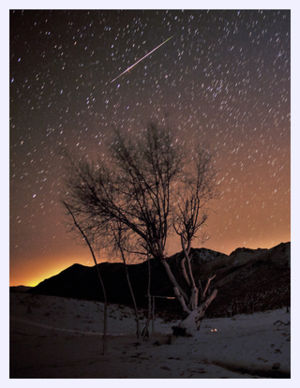
© Amir Hossein Abolfath (TWAN)
Fireball over Iran
NASA astronomers discover amino acids in meteorites that crashed into Sudan in 2008
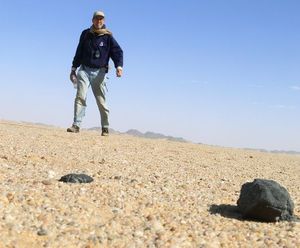
New evidence that space rocks may have seeded life on Earth.
Hot on the heels of finding arsenic-loving life-forms, NASA astronomers have uncovered amino acids - the fundamental foundation for life - in a place where they shouldn't be.
The acids - precursors of proteins - have been unexpectedly found inside
fragments of previously superheated meteorites that landed in northern
Sudan in 2008, a new study says.
Amino acids have already been found in a variety of carbon-rich meteorites formed under relatively cool conditions. (See asteroid and comet pictures.)
But this is the first time the substances have been found in meteorites
that had been naturally heated to 2,000 degrees Fahrenheit (1,100
degrees Celsius). That extreme temperature which should have destroyed
any hint of organic material inside, said study leader Daniel Glavin, an astrobiologist at NASA's Goddard Space Flight Center in Maryland.
"Previously, we thought the simplest way to make amino acids in an
asteroid was at cooler temperatures in the presence of liquid water,"
Glavin said in a statement. "This meteorite suggests there's another way
involving reactions in gases as a very hot asteroid cools down."
The discovery also "provides additional support for the theory
that life's ingredients were delivered to the Earth by asteroids," he
said.
ET Amino Acids a "Big Deal"
The meteorites came from a 13-foot-wide (4-meter-wide) parent asteroid that entered an Earth-crossing orbit in 2008.
A collision about 15 million years ago sent the 59-ton asteroid closer to Earth - and provided scientists the first opportunity to observe a celestial object before it entered our atmosphere in October 2008.
(See "Meteorites in Africa Traced to Asteroid 'Parent.'")
During desert treks, scientists later recovered nearly 600 meteorite fragments from the meteor shower.
"Finding evidence for the extraterrestrial amino acids in this meteorite
is a big deal," Glavin said, "since we can learn about the chemistry
that took place in space prior to the origin of life on Earth."
Likewise, "these meteorites would have contributed to the amino acid
inventory of the early Earth and other planets in our solar system,
including Mars."
This may mean that organic compounds such as amino acids - delivered via
asteroids - may have been much more pervasive throughout the solar
system than thought, he said.
The new meteorite research is featured in 20 papers published this week in an issue of the Meteoritical Society's journal Meteoritics and Planetary Science.
Bright Prospects for Comet Elenin?
It doesn't look like much now - just a 19th-magnitude smudge tucked
away in southwestern Virgo - but a newly discovered comet could
become something special 10 months from now.
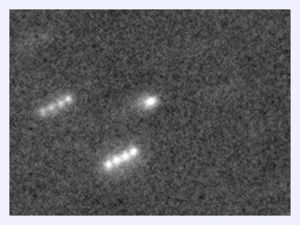
Comet
Elenin (C/2010 X1) made its debut on December 10th when Leonid Elenin,
an observer in Lyubertsy, Russia, remotely acquired four 4-minute-long
images using an 18-inch (45-cm) telescope at the ISON-NM observatory near Mayhill, New Mexico. Follow-up images by Aleksei Sergeyev and Artem Novichenko at Maidanak Observatory in Uzbekistan revealed more about the new find: a teardrop-shaped, very diffuse coma just 6 arcseconds across and a tiny tail.
What's gotten hearts beating a little faster since the discovery is that
Comet Elenin is still more than 4 astronomical units (375 million
miles) from the Sun and headed inbound. It's still early, and the orbit
is certain to change in the weeks ahead, but right now it appears the
comet's perihelion will occur well inside Earth's orbit, about 0.45 a.u.
(42 million miles) from the Sun, on September 5th.
Right now, odds are that Comet Elenin will become an easy target for
binoculars around mid-August and reach naked-eye visibility for a couple
of weeks around perihelion. The comet's elongation from the Sun shrinks to just 1°
following perihelion, but soon thereafter the comet gets enough
separate to position itself nicely for viewing in the predawn sky.

Fireball over Iran
NASA astronomers discover amino acids in meteorites that crashed into Sudan in 2008

© JPL/NASA
An increasingly frequent event: A meteorite (pictured) from an asteroid that crashed into Sudan's Nubian Desert in 2008.
An increasingly frequent event: A meteorite (pictured) from an asteroid that crashed into Sudan's Nubian Desert in 2008.
New evidence that space rocks may have seeded life on Earth.
Hot on the heels of finding arsenic-loving life-forms, NASA astronomers have uncovered amino acids - the fundamental foundation for life - in a place where they shouldn't be.
The acids - precursors of proteins - have been unexpectedly found inside
fragments of previously superheated meteorites that landed in northern
Sudan in 2008, a new study says.
Amino acids have already been found in a variety of carbon-rich meteorites formed under relatively cool conditions. (See asteroid and comet pictures.)
But this is the first time the substances have been found in meteorites
that had been naturally heated to 2,000 degrees Fahrenheit (1,100
degrees Celsius). That extreme temperature which should have destroyed
any hint of organic material inside, said study leader Daniel Glavin, an astrobiologist at NASA's Goddard Space Flight Center in Maryland.
"Previously, we thought the simplest way to make amino acids in an
asteroid was at cooler temperatures in the presence of liquid water,"
Glavin said in a statement. "This meteorite suggests there's another way
involving reactions in gases as a very hot asteroid cools down."
The discovery also "provides additional support for the theory
that life's ingredients were delivered to the Earth by asteroids," he
said.
ET Amino Acids a "Big Deal"
The meteorites came from a 13-foot-wide (4-meter-wide) parent asteroid that entered an Earth-crossing orbit in 2008.
A collision about 15 million years ago sent the 59-ton asteroid closer to Earth - and provided scientists the first opportunity to observe a celestial object before it entered our atmosphere in October 2008.
(See "Meteorites in Africa Traced to Asteroid 'Parent.'")
During desert treks, scientists later recovered nearly 600 meteorite fragments from the meteor shower.
"Finding evidence for the extraterrestrial amino acids in this meteorite
is a big deal," Glavin said, "since we can learn about the chemistry
that took place in space prior to the origin of life on Earth."
Likewise, "these meteorites would have contributed to the amino acid
inventory of the early Earth and other planets in our solar system,
including Mars."
This may mean that organic compounds such as amino acids - delivered via
asteroids - may have been much more pervasive throughout the solar
system than thought, he said.
The new meteorite research is featured in 20 papers published this week in an issue of the Meteoritical Society's journal Meteoritics and Planetary Science.
Bright Prospects for Comet Elenin?
It doesn't look like much now - just a 19th-magnitude smudge tucked
away in southwestern Virgo - but a newly discovered comet could
become something special 10 months from now.

© Leonid Elenin / ISON-NM
Comet
Elenin (C/2010 X1) appears as a tiny, faint smudge in this stack of
four 240-second exposures taken on the morning of December 10, 2010,
with a remote-controlled telescope in New Mexico. (The quadrupled stars
are due to the comet's motion between exposures.)
Comet
Elenin (C/2010 X1) appears as a tiny, faint smudge in this stack of
four 240-second exposures taken on the morning of December 10, 2010,
with a remote-controlled telescope in New Mexico. (The quadrupled stars
are due to the comet's motion between exposures.)
Comet
Elenin (C/2010 X1) made its debut on December 10th when Leonid Elenin,
an observer in Lyubertsy, Russia, remotely acquired four 4-minute-long
images using an 18-inch (45-cm) telescope at the ISON-NM observatory near Mayhill, New Mexico. Follow-up images by Aleksei Sergeyev and Artem Novichenko at Maidanak Observatory in Uzbekistan revealed more about the new find: a teardrop-shaped, very diffuse coma just 6 arcseconds across and a tiny tail.
What's gotten hearts beating a little faster since the discovery is that
Comet Elenin is still more than 4 astronomical units (375 million
miles) from the Sun and headed inbound. It's still early, and the orbit
is certain to change in the weeks ahead, but right now it appears the
comet's perihelion will occur well inside Earth's orbit, about 0.45 a.u.
(42 million miles) from the Sun, on September 5th.
Right now, odds are that Comet Elenin will become an easy target for
binoculars around mid-August and reach naked-eye visibility for a couple
of weeks around perihelion. The comet's elongation from the Sun shrinks to just 1°
following perihelion, but soon thereafter the comet gets enough
separate to position itself nicely for viewing in the predawn sky.

© Tenagra Observatories
Amateur
astronomer (and comet discoverer) Leonid Elenin lives near Moscow and
is an accomplished optician who likes to observe asteroids and variable
stars.
New Mexico Fireball on Christmas
Lunar Meteorite Hunter
Reported by Thomas Ashcraft.
Nice meteor over eastern New Mexico Dec 25 at 2218 MST evening. (Dec 26, 2010, 0518 UTC).
Interestingly, the slower and sometimes larger the fireball, the less
radio scatter reflection it creates. This one made just a subtle
"twinkle."
Click here to watch video clip.
2000th Comet Spotted By SOHO

As
people on Earth celebrate the holidays and prepare to ring in the New
Year, an ESA/NASA spacecraft has quietly reached its own milestone: on
December 26, the Solar and Heliospheric Observatory (SOHO) discovered
its 2000th comet.
Drawing on help from citizen scientists around the world, SOHO has
become the single greatest comet finder of all time. This is all the
more impressive since SOHO was not specifically designed to find comets,
but to monitor the sun.
"Since it launched on December 2, 1995 to observe the sun, SOHO has more
than doubled the number of comets for which orbits have been determined
over the last three hundred years," says Joe Gurman, the U.S. project
scientist for SOHO at NASA's Goddard Space Flight Center in Greenbelt,
Md.
Of course, it is not SOHO itself that discovers the comets -- that is
the province of the dozens of amateur astronomer volunteers who daily
pore over the fuzzy lights dancing across the pictures produced by
SOHO's LASCO (or Large Angle and Spectrometric Coronagraph) cameras.
Over 70 people representing 18 different countries have helped spot
comets over the last 15 years by searching through the publicly
available SOHO images online.
The 1999th and 2000th comet were both discovered on December 26 by
Michal Kusiak, an astronomy student at Jagiellonian University in
Krakow, Poland. Kusiak found his first SOHO comet in November 2007 and
has since found more than 100.
"There are a lot of people who do it," says Karl Battams who
has been in charge of running the SOHO comet-sighting website since 2003
for the Naval Research Lab in Washington, where he also does computer
processing for LASCO. "They do it for free, they're extremely thorough,
and if it wasn't for these people, most of this stuff would never see
the light of day."
Battams receives reports from people who think that one of the spots in
SOHO's LASCO images looks to be the correct size and brightness and
headed for the sun - characteristics typical of the comets SOHO finds.
He confirms the finding, gives each comet an unofficial number, and
then sends the information off to the Minor Planet Center in Cambridge,
Mass, which categorizes small astronomical bodies and their orbits.
It took SOHO ten years to spot its first thousand comets, but only five
more to find the next thousand. That's due partly to increased
participation from comet hunters and work done to optimize the images
for comet-sighting, but also due to an unexplained
systematic increase in the number of comets around the sun. Indeed,
December alone has seen an unprecedented 37 new comets spotted so far, a
number high enough to qualify as a "comet storm."
Comment: That is a number large enough to also
qualify as something to make us sit up and take notice. In addition to
an increase in comets around the sun, there has also been an increase in
the number of fireballs being spotted and even caught on video over the
past few years.
Take a look at our Comets & Catastrophes section down the page in the left margin for more information.
LASCO was not designed primarily to spot comets. The LASCO camera
blocks out the brightest part of the sun in order to better watch
emissions in the sun's much fainter outer atmosphere, or corona. LASCO's
comet finding skills are a natural side effect -- with the sun blocked,
it's also much easier to see dimmer objects such as comets.
"But there is definitely a lot of science that comes with these
comets," says Battams. "First, now we know there are far more comets in
the inner solar system than we were previously aware of, and that can
tell us a lot about where such things come from and how they're formed
originally and break up. We can tell that a lot of these comets all have
a common origin." Indeed, says Battams, a full 85% of the comets
discovered with LASCO are thought to come from a single group known as
the Kreutz family, believed to be the remnants of a single large comet
that broke up several hundred years ago.
The Kreutz family comets are "sungrazers" - bodies whose orbits
approach so near the Sun that most are vaporized within hours of
discovery - but many of the other LASCO comets boomerang around the
sun and return periodically. One frequent visitor is comet 96P Machholz.
Orbiting the sun approximately every six years, this comet has now been
seen by SOHO three times.
SOHO is a cooperative project between the European Space Agency (ESA)
and NASA. The spacecraft was built in Europe for ESA and equipped with
instruments by teams of scientists in Europe and the USA.
Bright Maryland Meteor Spotted Tuesday Evening
I came back today to two reports of a bright meteor visible from
Maryland Tuesday evening, Dec. 28, 2010. Details are still very sketchy.
But 25-or-so other people from Virginia to New England spotted
something similar at about the same time, according to fireball reports
to the American Meteor Society web site.
If you spotted it, too, we'd love to get your descriptions.
Please leave a comment, and describe where you were, the time and date
you saw the meteor, the direction you were looking and the direction of
the meteor's duration, movement and approximate angle above the horizon.
As an example: "Meteor moved from 40 degrees above the northeast
horizon to 20 degrees above the southeast horizon before
disappearing..." (On the horizon is zero degrees; straight up is 90
degrees.) Also include any color, visible trail or sounds.
The first report to us came from G. Mitchell, who emailed us at 9:18 p.m. Tuesday:
"Spotted a large green meteor tonight, approx, 6:50 p.m., moving east to
west, lasting about 6 sec. with a shower of green sparks following my
location 5 miles south of Pocomoke City, Md."
The second came from a former Evening Sun colleague,
Charles "Hap" Hazard. Still trying to reach him directly, but he left a
message Tuesday night reporting a "bright red" meteor that "shot across
the sky." Hazard was "near the Beltway and Reisterstown Road."
I need more detail than that, Hap. Put on your reporter's hat and call
me. Everyone else, please leave a comment below. And, obviously, if you
happened to capture it on a security camera, still image or video, send
it along! Thanks!
Amateur
astronomer (and comet discoverer) Leonid Elenin lives near Moscow and
is an accomplished optician who likes to observe asteroids and variable
stars.
New Mexico Fireball on Christmas
Mon, 27 Dec 2010 00:52 CST
Lunar Meteorite Hunter
Reported by Thomas Ashcraft.
Nice meteor over eastern New Mexico Dec 25 at 2218 MST evening. (Dec 26, 2010, 0518 UTC).
Interestingly, the slower and sometimes larger the fireball, the less
radio scatter reflection it creates. This one made just a subtle
"twinkle."
Click here to watch video clip.
2000th Comet Spotted By SOHO

© SOHO/Karl Battams
SOHO's 2000th comet, spotted by a Polish amateur astronomer on December 26, 2010.
SOHO's 2000th comet, spotted by a Polish amateur astronomer on December 26, 2010.
As
people on Earth celebrate the holidays and prepare to ring in the New
Year, an ESA/NASA spacecraft has quietly reached its own milestone: on
December 26, the Solar and Heliospheric Observatory (SOHO) discovered
its 2000th comet.
Drawing on help from citizen scientists around the world, SOHO has
become the single greatest comet finder of all time. This is all the
more impressive since SOHO was not specifically designed to find comets,
but to monitor the sun.
"Since it launched on December 2, 1995 to observe the sun, SOHO has more
than doubled the number of comets for which orbits have been determined
over the last three hundred years," says Joe Gurman, the U.S. project
scientist for SOHO at NASA's Goddard Space Flight Center in Greenbelt,
Md.
Of course, it is not SOHO itself that discovers the comets -- that is
the province of the dozens of amateur astronomer volunteers who daily
pore over the fuzzy lights dancing across the pictures produced by
SOHO's LASCO (or Large Angle and Spectrometric Coronagraph) cameras.
Over 70 people representing 18 different countries have helped spot
comets over the last 15 years by searching through the publicly
available SOHO images online.
The 1999th and 2000th comet were both discovered on December 26 by
Michal Kusiak, an astronomy student at Jagiellonian University in
Krakow, Poland. Kusiak found his first SOHO comet in November 2007 and
has since found more than 100.
"There are a lot of people who do it," says Karl Battams who
has been in charge of running the SOHO comet-sighting website since 2003
for the Naval Research Lab in Washington, where he also does computer
processing for LASCO. "They do it for free, they're extremely thorough,
and if it wasn't for these people, most of this stuff would never see
the light of day."
Battams receives reports from people who think that one of the spots in
SOHO's LASCO images looks to be the correct size and brightness and
headed for the sun - characteristics typical of the comets SOHO finds.
He confirms the finding, gives each comet an unofficial number, and
then sends the information off to the Minor Planet Center in Cambridge,
Mass, which categorizes small astronomical bodies and their orbits.
It took SOHO ten years to spot its first thousand comets, but only five
more to find the next thousand. That's due partly to increased
participation from comet hunters and work done to optimize the images
for comet-sighting, but also due to an unexplained
systematic increase in the number of comets around the sun. Indeed,
December alone has seen an unprecedented 37 new comets spotted so far, a
number high enough to qualify as a "comet storm."
Comment: That is a number large enough to also
qualify as something to make us sit up and take notice. In addition to
an increase in comets around the sun, there has also been an increase in
the number of fireballs being spotted and even caught on video over the
past few years.
Take a look at our Comets & Catastrophes section down the page in the left margin for more information.
LASCO was not designed primarily to spot comets. The LASCO camera
blocks out the brightest part of the sun in order to better watch
emissions in the sun's much fainter outer atmosphere, or corona. LASCO's
comet finding skills are a natural side effect -- with the sun blocked,
it's also much easier to see dimmer objects such as comets.
"But there is definitely a lot of science that comes with these
comets," says Battams. "First, now we know there are far more comets in
the inner solar system than we were previously aware of, and that can
tell us a lot about where such things come from and how they're formed
originally and break up. We can tell that a lot of these comets all have
a common origin." Indeed, says Battams, a full 85% of the comets
discovered with LASCO are thought to come from a single group known as
the Kreutz family, believed to be the remnants of a single large comet
that broke up several hundred years ago.
The Kreutz family comets are "sungrazers" - bodies whose orbits
approach so near the Sun that most are vaporized within hours of
discovery - but many of the other LASCO comets boomerang around the
sun and return periodically. One frequent visitor is comet 96P Machholz.
Orbiting the sun approximately every six years, this comet has now been
seen by SOHO three times.
SOHO is a cooperative project between the European Space Agency (ESA)
and NASA. The spacecraft was built in Europe for ESA and equipped with
instruments by teams of scientists in Europe and the USA.
Bright Maryland Meteor Spotted Tuesday Evening
I came back today to two reports of a bright meteor visible from
Maryland Tuesday evening, Dec. 28, 2010. Details are still very sketchy.
But 25-or-so other people from Virginia to New England spotted
something similar at about the same time, according to fireball reports
to the American Meteor Society web site.
If you spotted it, too, we'd love to get your descriptions.
Please leave a comment, and describe where you were, the time and date
you saw the meteor, the direction you were looking and the direction of
the meteor's duration, movement and approximate angle above the horizon.
As an example: "Meteor moved from 40 degrees above the northeast
horizon to 20 degrees above the southeast horizon before
disappearing..." (On the horizon is zero degrees; straight up is 90
degrees.) Also include any color, visible trail or sounds.
The first report to us came from G. Mitchell, who emailed us at 9:18 p.m. Tuesday:
"Spotted a large green meteor tonight, approx, 6:50 p.m., moving east to
west, lasting about 6 sec. with a shower of green sparks following my
location 5 miles south of Pocomoke City, Md."
The second came from a former Evening Sun colleague,
Charles "Hap" Hazard. Still trying to reach him directly, but he left a
message Tuesday night reporting a "bright red" meteor that "shot across
the sky." Hazard was "near the Beltway and Reisterstown Road."
I need more detail than that, Hap. Put on your reporter's hat and call
me. Everyone else, please leave a comment below. And, obviously, if you
happened to capture it on a security camera, still image or video, send
it along! Thanks!
US: Witnesses Startled by Shooting Star Over Frederick
It wasn't a bird.
It wasn't a plane.
It wasn't even ... well, you know, but there was something that zipped
across the evening sky at about 6:50 p.m. Tuesday and a number of area
folks say they saw it.
"I tell you what, the hair stood up on the back of my neck," said Al
Labrush, a veteran meteorite watcher and collector. "It was
frightening."
Labrush said he was standing near Danielle's restaurant downtown when he
caught sight of something that looked to be about 1,500 feet away.
"I heard this sizzling behind me. ... I turned and looked: This
huge meteorite came. ... It was throwing off sparks and chunks," Labrush
said. "I'm into meteorites -- every time they call for meteor showers,
I'm out. I very seldom get scared -- (but) I never want to see another
one like that."
Steve Lawrence saw it, too.
Lawrence was driving home on Old Kiln Road when he saw the bright object
in the northern sky, "like a fireball," through the passenger side
window.
Three white flashes erupted, lighting up the night like daylight for an
instant, and then it all seemed to disintegrate, he said. "Night turned
to day," Lawrence said. "The flash was like heat lightning."
Sean Dennison saw it, too -- from Hagerstown.
Dennison, who works with Lawrence, was walking from his house
to his car when he saw it. It was so unusual that he went back inside to
tell his wife, before heading out to play racquetball.
He heard Lawrence talking about the bright light Wednesday and chimed in.
"I saw the same thing," said Dennison, who compared the white
brightness to burning magnesium, and the object moved slower than a
falling star. "A burst of sparkles," like fireworks, concluded the
scene, he said.
Lawrence said he watched a plume of smoke hanging in the night sky for 20 minutes.
Robert Gutro, a NASA deputy news chief, said he took a call from a woman
he did not know who telephoned Tuesday to report what she had seen.
"She was kind of panicked," Gutro said. She described the bright object
moving across the sky, and it "broke up into pieces," he said.
A spokesman for the North American Aerospace Defense Command said NORAD
did not report tracking anything, which rules out so-called "space
junk," such as out-of-commission satellites.
Frederick County Emergency Communications reported no calls about it.
If it was a meteor, it likely left a trail of debris, said expert John
Wasson at the University of California at Los Angeles. He said it
sounded like a meteor is probably what people saw.
Wasson predicted that meteor hunters such as Mike Farmer of Tucson, Arizona, would be on the trail before anyone else.
Farmer said he surely would be.
"Normally, I would jump on the plane and come out," Farmer said when
reached by telephone. But Wednesday he was preparing to go to the Middle
East on an expedition.
Farmer was not aware of any meteoric activity here, but based on the
accounts of Tuesday's event, he said he would have people look into it.
Lawrence said he had the unsettling feeling that whatever it was fell
less than a mile from his house, and he planned to look for evidence.
"You need to experience that right behind your house," he said.
US: Meteors Scream Over Maryland for Past Two Nights
For a second night in a row, Maryland residents have reported large fireballs coursing through the night sky.
The latest apparent meteor sighting occurred around 9:30 p.m. Wednesday
and set Twitter alight with wondrous didja-see-thats??! "Whoa," reported
Chris Noonan Sturm. "I think I just saw a meteor scream to earth over
Rockville & 270 while walking dog. Crazy fast. Started white, turned
green, red." Others chimed in to say they saw a "white ball" shoot over
the horizon in Gaithersburg; one person said it "flared out" after
flying over Clopper, Md.
On Tuesday, the sky over Frederick and Hagerstown
lit up like daytime when what must have been an epic meteor broke
through the atmosphere. The Frederick Post was quickly on the story,
gathering the most terrifying quote perhaps ever printed about shooting
stars:
"I heard this sizzling behind me. ... I turned and looked: This huge
meteorite came. ... It was throwing off sparks and chunks," Labrush
said. "I'm into meteorites - every time they call for meteor showers,
I'm out. I very seldom get scared - (but) I never want to see another
one like that."
One onlooker described "a plume of smoke hanging in the night sky for 20 minutes."
And others wrote in to Maryland Weather with these sightings:
"Spotted a large green meteor [Tuesday], approx, 6:50 p.m., moving east
to west, lasting about 6 sec. with a shower of green sparks following my
location 5 miles south of Pocomoke City, Md."
"I thought it was a plane but the back seemed almost to be sparking with
different colors, like a firework, and leaving a small trail behind
it."
"The streak lasted about five or six seconds. I thought of two things
when I saw it. First, maybe someone is celebrating New Years early and
popped off some fireworks. Second, gosh that looks like the footage of
the shuttle accident a few years ago as it broke up in the atmosphere.
The streak of light was white and yellow with greens and blues breaking
off of it."
These sound like some particularly bad-ass meteors. Has anybody else been lucky enough to spot them?
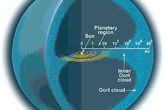
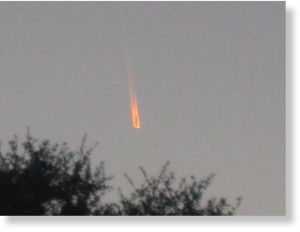
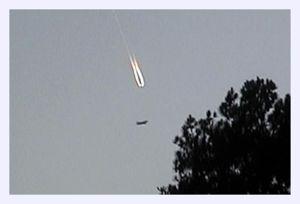
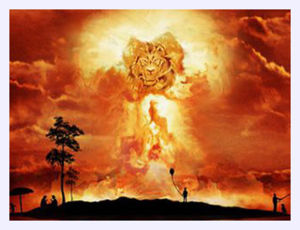
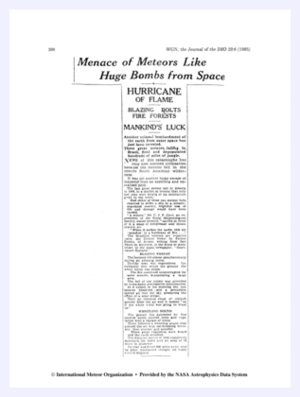

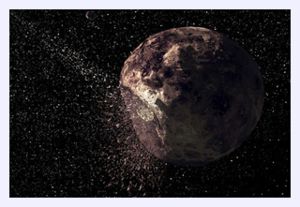
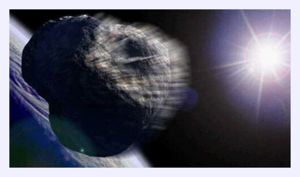
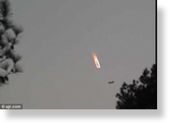
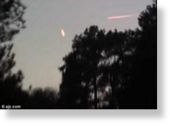
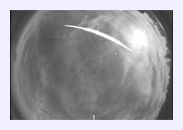
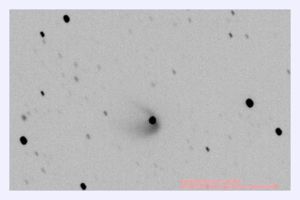

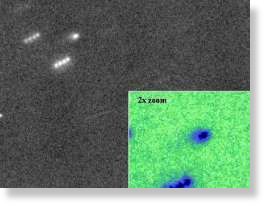
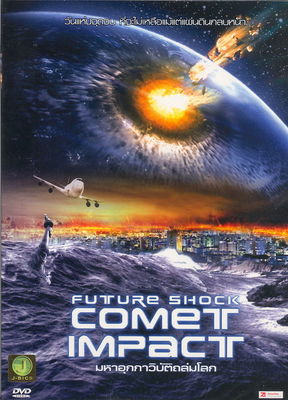
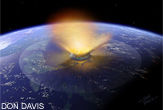


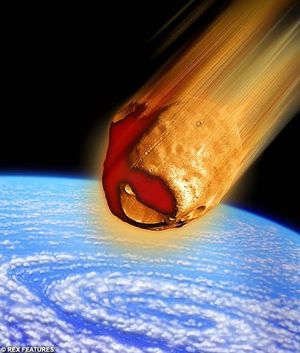

No comments:
Post a Comment